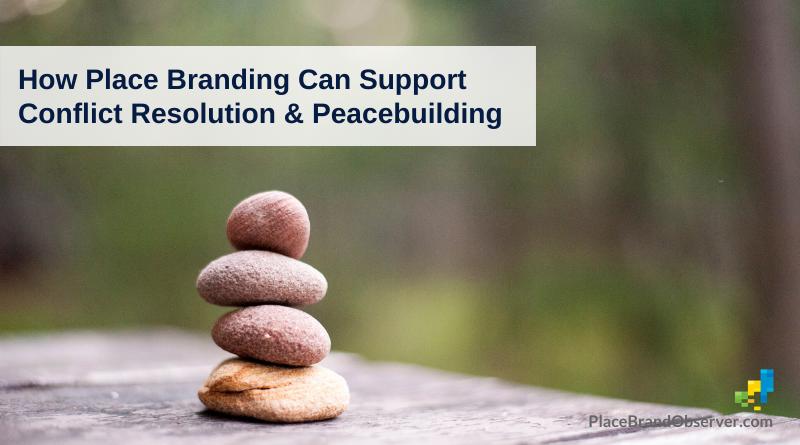Place branding as a tool for conflict resolution and peacebuilding: how can place branding methodologies help ease internal tensions in fragmented societies, or societies that are recovering from conflict? Can place branding be used in that way and if so, how?
Those are timely questions in a world with multi-cultural communities and a growing population – prone to experiencing more and more tension and dispute over limited space and resources. Below the answers of our panel of place branding specialists (in alphabetical order – highlighted respondents are available for consulting, research or as speakers).
A few key takeaways:
- Place branding helps in providing a fresh impetus post-conflict through focused storytelling, by highlighting the positives of a place.
- The objective should be about overcoming negative press and burying differences, to focus on the present and work towards a common goal to reap benefits in the future – both economic and for harmonious living.
- It is imperative to involve all the stakeholders in the decision-making process of brand building.
- A bottom-up approach works best since it involves everybody, from grassroots community groups to higher levels of decision-making.
- Trust is vital to bring out the best from all the groups.
- Place branding can provide a sense of unity among a reconciled group, and can assist in collective image building, giving all parties a representation and voice.
- Finding common ground among the diverse participating groups is the most important step in the branding process.
- Place brands can help visitors to identify with a place and its communities, leading to stronger tourism and a boost to economic development in the region.
Adam Mikolajczyk
I have not encountered the use of place branding for this purpose. I am not convinced that it would be useful. However, it seems to me, that the place branding process will be useful when creating and promoting (manifesting) a new identity, for example for a country after conflict. What is more, one of the best campaigns for me was created in this spirit – The Kosovo Nation Branding Campaign Ad.
I also think that place branding can be considered a useful conflict prevention tool. Thanks to strengthening and promoting local identity and loyalty to a given place.
Andrea Lucarelli
I am a bit skeptical to equate place branding with peacebuilding or conflict resolution. However, the way branding can work in these matters is to build a platform where different stakeholders can have a say and partake. Thus, it is imperative that the entire process is not top-down but is developed as participatory and bottom up.
However, branding as it is used in many cases today is also a way to “bracket” and “essentialize” a location, place or even populations. Therefore, the counter producing effect of using place branding in these matters of conflict resolution is always around the corner.
 Andrew Hoyne
Andrew Hoyne
As a tool for conflict resolution, there is a role for place branding to play. When done well, a strong place brand will create an inspiring and believable vision of a community and a strong sense of belonging and purpose. This will help to instill a sense of community pride, and economic opportunity – which people can rally around, creating community cohesion among disparate groups. Creating a sense of unity out of one of discords.
However, it is the power of collaboration which is most important when it comes to branding methodologies and conflict recovery.
At its essence this kind of work is about unifying and finding common ground among people and building a shared vision. But a shared vision is often a varied vision. A shared vision encompasses the needs and wants of a variety of people and interest groups. To move past conflict, I would imagine consensus and collaboration is crucial. Therefore, consultation and participation from various groups in the ground work for this kind of branding would be essential. You would need to ensure consultation was done to reach a “vision”, then the agreed vision becomes something everyone can work towards. And it can and should be something that can be applied across all kinds of sectors (tourism, business investment, internal comms etc.) and work for them equally.
At its essence a place brand is really a blueprint for the future we want to create for that place – one with community engagement, economic prosperity for all – acknowledging its past, celebrating its present and moving it towards a brighter future.
 Caio Esteves
Caio Esteves
A place brand is a collaborative construction. In this way it is in the very nature of the place branding process to mediate conflicts by negotiating a joint vision from sometimes conflicting opinions.
Creating a place brand is often dealing with the paradox itself, not choosing option A, B or C, but a new path resulting from the mediation process. Place branding can be an important approach in discussing these new paths (even though we might want to use another term to avoid negative connotations with “brand”).
 Christopher Hire
Christopher Hire
This is an interesting question. Place branding as a behaviour change tool is from the ‘nudge’ school of theories.
While conflict resolution has well documented techniques, perhaps a positive place brand is a long-run strategy in resolving the consequences of tension.
Branding of course cannot overcome genuine diplomatic tension, but it could assist in creating positive images to replace negative images.
But one must be careful not to overreach.
 Ed Burghard
Ed Burghard
Theoretically, any collaborative effort can help promote understanding among diverse groups. However, as a dose of realism, effective place branding requires trust. In any regional collaboration both players give up control of something and rely on their partner to deliver with at least the same degree of excellence expected if done themselves. The partnership performance must be accretive versus going alone. In areas fraught with political strife, trust is dear.
My concern is that any collaborative place branding effort might be doomed from the start until a base level of trust and mutual respect is created.
Eduardo Oliveira
Multiple causal relationships exist between conflict resolution and place branding strategies. While conflict resolution is well equipped to bring about temporary settlements and brief periods of peace in volatile situations, conventional conflict resolution techniques are not capable of building long-term stability.
Place branding methodologies could be useful in bringing about a balance of powers in situations of predominantly non-violent and violent in nature, for example, or other forms of conflict. In addition, place branding could become useful to enhance a place’s sense of ontological security and self-esteem.
Usual approaches to conflict resolution have equals meet equals: generals with generals, leaders with leaders, grassroots with grassroots. Efforts have tended towards these kinds of horizontal relationships, with the idea of fostering interdependence, building relationships across the major line of social cleavage along which the conflict is formed.
Place branding – if done well that is bottom-up initiatives support through participation both vertically (from grassroots to higher levels of decision making) and horizontally (across equal levels of decision making, such as governments) – then could work to decrease tensions within societies and among territories.
It is, however, important that places, such as nations, understand place branding as a means to upholding and enhancing a sense of self-esteem and national dignity within spheres of cooperation and mutual support, rather than competition.
Place branding strategies would become more effective in situations of conflict if able to convey messages that togetherness makes nations stronger and not the opposite.
It is also paramount that nations understand sources of global conflict, such as conflicts over land use and natural resources management, as trans-boundary issues. These cross-border issues have to be addressed through collective strategies.
Place branding could be a useful instrument to unite nations together around the same issue and then advance united to solve it. For instance, it would be a great humanitarian gain if South American countries would unite to protect the Amazon rainforest, instead of accusing each other of inaction or constantly blaming illegal logging and criminal networks without concrete measures to address these criminal acts Perhaps if they understood better the negative consequences of a bad reputation, they would invest more in place branding strategies as an instrument of landscape conservation and not a profit-making mechanism.
 Efe Sevin
Efe Sevin
- Let’s not forget that, at the end of the day, place branding is a public policy matter.
- Place branding projects, provided that views of all stakeholders are represented, help residents get together behind new ideas.
- A strong place branding project will help communities visualize their future.
- Setting the priorities right is important in post-conflict societies. Place branding is not necessarily about tourism or investment – it is about identity.
- Kosovo’s “Young Europeans” campaign was such an example. From overall strategy to visuals used, the campaign painted the picture of a country rebuilding itself as a European country.
 Günter Soydanbay
Günter Soydanbay
Soydanbay Consulting / Speaker
Let me start from the very end and work my way backwards. Yes, place branding “methodologies” could be used to help ease internal tensions in societies that are recovering from conflict. That said, in such situations, the process should not be named as place branding, but as dialogue, for the use of the former could bring out the society’s “cynic, saboteur, and accuser within.”
As the word suggests, a dialogue requires the presence of multiple parties. If conflict resolution and peacebuilding are indeed the goals, then the place should invite all impacted parties to the table. Leaving even one out is enough to knock the legs out from under the project. After all, people support only what they help create.
Another thing to remember is that places are complex stakeholder organizations. The tiniest town is infinitely more complex than the largest company in the world. Complex stakeholder organizations cannot be controlled, but they can be steered. To that end, a memory of the future has more grip than a memory of the past. So, the goal should be to discover the shared vision – not the common denominator. The latter is past-oriented, whereas the former is future-looking.
Finally, let’s finish with an African proverb: “If you want to go fast, go alone. if you want to go far, go together.” Place branding projects move notoriously slowly. We could assume that the pace would be even slower if there are internal tensions, fragments, and conflict. Therefore, when using place branding methodologies, one should have looser timelines.
 Hjörtur Smárason
Hjörtur Smárason
Scope Communications / Speaker
There are two ways in particular where place branding is a useful tool to help ease internal tension and help with peacebuilding:
- Place branding brings the focus from what divides us to what unites us. The strengths that the combination of different groups give. It is a process that reminds people of all the good they have in common (despite any differences) and that they may have more to lose than they gain from allowing tensions to escalate. It also helps people to perceive themselves in a larger context of nations, rather than local fractions, and understand that the hindrance to them reaching their goals is maybe not the rivalling fraction but rather the negative perception the World has of the place. Tensions don’t fix that, but a collective strategy might.
- Brand positioning. Place branding is not just about what your place’s brand positioning is now, but also what you want it to be in 10, 20 or 30 years from now. Having people unite behind a common goal can be a very powerful force. It turns the discussions away from “who the present is to blame”, towards “how we can reach our future common goals”. And the best way to do that is always through cooperation.
Irina Shafranskaya
Place branding sometimes is the reason for conflicts and the overtourism issue is the best example. Can we resolve conflicts via branding activities? Definitely yes, if two conditions are fulfilled:
- we (place brand managers, local authorities etc.) share our pains and gains with respect to place brand. Activation is the first key – whatever we do under the umbrella of place branding activities, everyone should have space for sharing their concerns.
- awareness: no doubt that the place brand is to be clearly communicated and argued.
Our research on place brand participation (via mega-events) illustrates that residents are ready to participate in brand-related activities targeted towards tourists, but they want their opinion to be heard. So all the platforms which help to communicate can add value and resolve misunderstanding.
Another thing is the financial side – taxpayers are not willing to pay for the logos. But this just increases the importance of engagement and openness. Charity and pay-what-you-want mechanics could be helpful though not covering the costs. But in case you have a choice whether to use them or not, the small probability to earn definitely exists.
Jordi de San Eugenio Vela
In my view, place branding can be a useful tool for conflict resolution and peacebuilding on the basis of its relationship with public diplomacy. According to the relationship between place branding and public management of places, and specifically, on the management of place image, public diplomacy works on the improvement of the international reputation of countries, and, in that sense, the values directly related to peace, freedom, openness and respect for human rights could be some powerful arguments to build a strong place branding strategy. See one example of this here.
José Pablo Arango
Uniting the inhabitants of a country around a common purpose, to regain confidence and reduce tensions is one of the possibilities of a country branding project. The important thing is to find causes that mobilize and are not political.
Marta Herézniak
Used wisely, place branding has a strong potential of becoming an internal conflict appeaser, mostly because of its ability to commence discussion about conflicting values and identities that need to be redefined. If public discussion on controversial issues is held responsibly, with wide community participation, the process of recovery can begin.
An example that can serve as an illustration is the branding initiative of Germany from the late 90s to early 00s, after the country’s historic reunion, with two conflicting mentalities and identities colliding. The project was preceded by a nation-wide debate which involved over six hundred thousand citizens sharing their insights on a special interest platform, TV programme and other channels.
The ideas generated through the public debate subsequently inspired the renewed country brand identity, which – in turn – was translated into large scale brand-centric projects, the most high-profile of them being the World Football Championships in 2006.
 Natasha Grand
Natasha Grand
A very simple answer, theoretically, is that place branding reminds people about their shared values. If the place, its prosperity and development, can be presented or made to matter more than other allegiances that tear people apart, we have the common ground to build upon.
Yet, overcoming those other competing allegiances (religion, tribe, ethnicity) is a massive effort that requires equal, or greater, resources. Hence what is easy in theory may prove very challenging in practice.
Rebecca Smith
New Zealand has recently experienced a terrorist attack which brought the issue of conflict and peace to the fore in our nation. For us, having a clearly articulated set of values and a team set up to manage the nations messages across a range of channels meant we were able to act immediately delivering a set of consistent key talking points across both Government and the Private sector as well as provide context and content to media and global observers.
Having a Country Brand programme in place means you’re able to communicate what you stand for and can guide positive actions for balance in a conversation overshadowed by coverage of conflict.
 Robert Govers
Robert Govers
Independent advisor / Speaker / Researcher
I think that place branding can be used for peacebuilding as it is fundamentally about analysing local sense of belonging, identity, comradeship and shared purpose. Only with a strong sense of community can one hope to be able to influence external perceptions; partly because it builds ambassadorship. At the same time, it emphasises the major challenge as community building will be very hard in fragmented post-conflict societies. It requires lots of dialogue, reconciliation and leadership.
Maybe an example can be found in The Truth and Reconciliation Process that was conducted in South Africa after the end of apartheid.
 Sebastian Zenker
Sebastian Zenker
A place brand can have the potential to create a strong “we” and join people behind strong place narratives and behind a common goal. However, most of the times, this is hard to achieve, as place brand strategies often follow the goal of particular interest groups, sometimes even fuel the fragmentation of societies. In addition, a place brand should not be overstated: it is no ‘mana from heaven’.
The quote from Gregory Ashworth, “get your place fixed first”, is a strong reminder of that. A place brand can only work if the place works. If conflicts are too strong, a place brand will not help here.
 Todd Babiak
Todd Babiak
At its best, a place brand should be a unifying cultural expression. Place brand activities, based in that expression, should solve real problems. Of course, you’ll never have 100% unity in what it means to live where we live. But if you do your research properly, listen to people, and work with them to bring the brand to life it should bring people together around a common story and purpose.
That said, when we tap into deep emotional reservoirs to inform our place branding research, we should be careful not to exacerbate ethnic or religious tensions that can ultimately divide us. It should be an invitation, a welcome, which is a gesture of healing.
 Tom Buncle
Tom Buncle
Yellow Railroad Consulting / Speaker
Imagining place branding as a tool for conflict resolution is like fighting tanks with jellies. It’s not a solution. First the issues that caused the conflict need to be addressed through serious diplomacy. Unless this is done first, any other activity is no more than sticking plaster on an open wound – futile.
But, once the issues that gave rise to the conflict have been addressed, then place branding can contribute to peacebuilding. At this stage it can be powerful – by providing a shared narrative for the place, which both sides will hopefully buy into as a way forward and a basis for kick-starting economic development – but only AFTER a degree of stability has been established.
In short, the best antidote to conflict is prosperity. Tourism can accelerate the growth of prosperity. This is about creating a shared vision of the place, in full recognition that, whatever warring factions think, it is how outsiders (potential tourists, investors and media) perceive the place that counts once the conflict is over. It is also about creating hope, by providing a platform upon which to build a new future, which will identify shared goals, help maintain a sense of common purpose, and inspire forward momentum.
There will still be differences in perspective. But tourism offers two major advantages in helping economic recovery for post-conflict societies, in that it is the least controversial and most affordable method of kick-starting economic development after the scourge of conflict:
- The brutal truth inherent in tourism development for post-conflict societies, which no conflict can change, is that visitors will vote with their feet and decide where they visit: no amount of conflict can move a mountain to the other side for hikers; ancient ruins and heritage attractions can’t be relocated across the front line. Whereas arguments can go on forever, and further fuel conflict, about which side of the sectarian divide to locate a new factory or build a new plant.
- Developing tourism in conflict-ravaged and, inevitably, cash-depleted countries costs far less than any other major sector. The main requirement is investment in marketing, assuming some visitor infrastructure remains; whereas other significant job-creating sectors such as manufacturing generally require significant investment in new buildings, plant and machinery.
In this way, once the conflict is over, tourism can be a powerful force for peacebuilding.
Previous questions answered by the panel here
You’d like to ask the panel a question? Get in touch!
Enjoyed this summary of expert views on how place branding can support conflict resolution and peacebuilding? Thank you for sharing!


